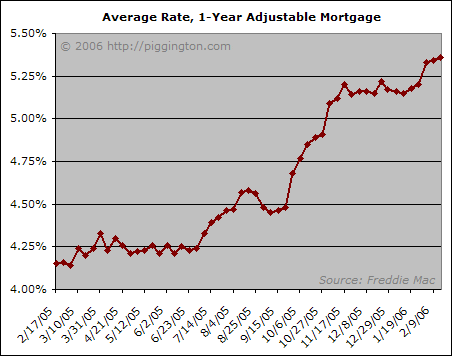Rates are on the rise again, Bernanke has given us some hints as to what’s in store for his first few months, and two US Senators threaten to inadvertently burst the housing bubble in March. The various goings-on in the credit markets, and their likely effect on San Diego housing, are discussed below.
After a sharp interest rate rise in the wake of Hurricane Katrina, the housing market finally caught a bit of a break starting in November when ARM rates flattened and fixed rates actually began to decline. It appears now that the two-month respite may be ending:


Rates for both adjustable and fixed mortgages have been on the rise for about a month. ARM rates are at a new high 5.36%, while fixed rate mortgages are at 6.28%, lower than November’s high but not by much.
ARM rates are by far the more important of the two, because a large majority of San Diego homebuyers use ARMs, and because the short-term rates affect both new homebuyers and prior homebuyers whose adjustable mortgages are resetting. As we’ve been discussing for a while now, the spike in ARM rates that took place starting last summer has dealt a real blow to the market. Any hope for a springtime recovery rests on credit conditions getting a lot easier, and if last month’s mortgage market behavior was any indication, that’s starting to look less likely.
Our new Federal Reserve chairman does not appear poised to ride to the rescue either. I’ve discussed in previous writings the fact that I think Bernanke might eventually flood the market with easy money if the economy goes south. But we aren’t anywhere near there yet, and for now, Bernanke appears to be trying to establish himself as tough on inflation. He made plenty of allusions to inflation risks in last week’s testimony before Congress, and said that while "substantial progress" had been made in normalizing rates, "some further firming of monetary policy may be necessary."
For what it’s worth, the consensus forecast currently calls for two more rate hikes, one in March and one in May. If this is correct (and that’s a big if, as nobody really knows how the new Fed "administration" will approach the current monetary situation) then we will likely see ARM rates continue to meander to the upside.
Meanwhile, another source of rate risk is brewing as Senators Schumer and Graham are once again pitching their misguided 27.5% tariff on Chinese imports if the Chinese don’t revalue their currency.
This bill, which they are threatening to bring to vote in March, would almost certainly cause rates to rise if passed. The bill would probably cause the Chinese to relent and let their currency rise, which would render Chinese goods more expensive to us and thus increase consumer price inflation. With higher inflation, of course, comes higher rates.
On top of this, letting their currency rise against the dollar would probably entail the Chinese buying fewer US bonds or even selling our bonds, which would have a further rate-increasing effect as demand for US bonds diminished. (If this doesn’t make sense, some background can be found in the article on the history of the housing bubble.) Even if the Chinese did not let their currency rise, and took the hit on the 27.5% tariff, the tariff itself would still cause a spike in CPI inflation and thus exert upward pressure on interest rates.
It’s not clear to me how likely the bill is to get passed, but it certainly bears watching as it could have serious unintended consequences in the housing market. For now, we will just have to keep an eye on how this situation develops.
Conclusion
The consensus is forecasting a springtime rally in the housing market, mainly because such a rally has taken place every spring in recent memory. The problem is that the 2005 spring rally was pretty weak, and more importantly took place with ARM rates steady at around 4.25%. ARM rates have now risen to 5.36%, representing a 12% decrease in the amount of house that the same monthly payment can provide. A spring rally is unlikely unless credit conditions ease substantially between now and then.
Rather than falling back towards early-2005 levels, however, rates appear to be on the rise again. If the Fed indeed stays the tightening course, it’s unlikely that rates will drop enough to allow a springtime rally. And if the protectionists in Congress get their way, things could go from bad to worse in the interest rate department.
Overall, it appears that the credit market appears poised to continue putting downward pressure on housing market activity and prices. Given these mortgages conditions, along with San Diego’s growing inventory and dawning recognition of a serious housing slowdown, the market will likely continue to weaken in the months ahead.
